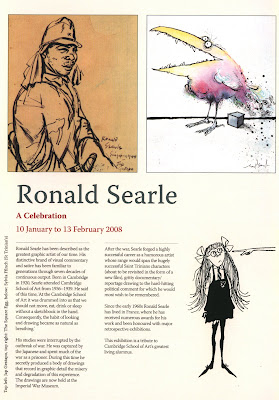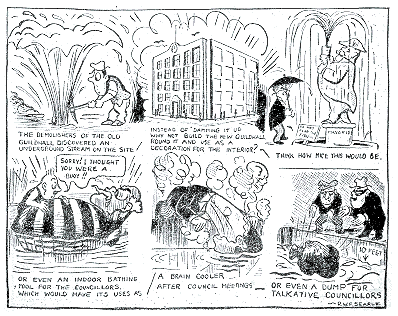
'Ronald Searle: A Celebration'
Report on Exhibition at Anglia Ruskin University, Cambridge
Despite being a longtime fan of Ronald Searle, I have seen precious few exhibitions of his work in his native country, the last one being back in 2003 at Chris Beetles Gallery, London. I was delighted to therefore discover that the Anglia Ruskin University in Searle's birthplace city Cambridge were holding a small display of his work in the Ruskin Gallery.
Coming from around Cambridge myself, it was a prime opportunity to study the master's work up close and in detail on home turf!
Driving into Cambridge I aptly passed over Elizabeth Way, a bridge spanning the Cam and the original location of the house in which Searle was born, sadly since demolished. The Ruskin gallery is a small yet spacious room situated at the back of the Ruskin campus near the centre of the city. There was a modest amount of Searle's work on display, most of it
on loan from Chris Beetles Gallery, London. Around the gallery are classrooms where students take lessons in art; to be surrounded by and be able to pass by Searle's work everyday is an enviable position to be in!

I feel Searle's best work was during the 50's when he was able to achieve a perfect marriage between observational drawing and caricature. There were some fine examples from this period, and being able to study them up close and at actual scale impressed upon me not only Searle's ability for beautiful loose linework but also the delicacy and fine lines in his work which is lost in many shrunken reproductions.
The detail on a rose, or the stunning intricacies of a car's bonnet truly astound as one's eyes try to lap it all up. Being able to appreciate his use of inks, crayons and pastels up close impresses upon one the visual variety and varying tonal qualities of his work, which can be lost in books. Indeed some of Searle's linework is so delicious one just wants to gorge on the picture as a whole and try to take in the sheer beauty of his compostions.

Of particular note were some original posters Searle designed for 'Lemon Hart Rum', a series of which ran nationwide on billboards during the 50's. To see these up close was superb - under the paint it was possible to see where Searle had roughed out in pencil the original layout, before working over it in paints. There was a wonderful roughness to these
large colour pieces, with Searle's brushwork mirroring the looseness of his linework. Indeed some parts of
the work even seem unfinished and unrefined, but when looked at as a whole there is a beautiful flow and feel to the pieces.

Aside from the obvious and oft reproduced works from Searle's prolific career, including his 'Cats' work and 'St. Trinian's' of which are few were on display, there were a couple of gems exhibited around the gallery which were the highlights for me.
Searle created cartoons for the Cambridge Daily News in his late teens, and an example from these early days was on loan from the newspaper, focusing on a recent spate of book borrowing from the local library.
Despite the obvious lack of refinement in the drawing, it is clear from this early piece that Searle was already aquainted with basic forms of cartooning and caricature which he would go on to refine and master in later years. Everyone has to start
somewhere and despite the fact it does not resemble his later post war work, there are glimpses of the drawings which were to come.

Lastly there was a cabinet in the middle of the gallery containing sketches, roughs and early draft versions of Searle's work. After intially missing this treasure trove, this was the undoubted high point of the exhibition - being allowed to see how Searle approached his work. There were rough mock ups for the Lemon Hart posters, loosely blocked in on a small ,A4 sized piece of paper. Tantalisingly out of reach were a couple of his theatre sketchbooks whilst working for Punch in the late 50's, used by Searle to jot down notes and sketches to produce the final image back in his studio. Maddeningly you could only see into a couple of the pages, where he had made shorthand studies of the actors in pencil whilst crammed into a small london theatre. A couple of letters from his studio displaying his elegant handwriting and a work in progress edition of 'The St Trinian's Story', as well as an edition of Searle's earliest publications '40 Drawings' were also on display. Finally a selection of photos from Searle's youth around Cambridge could be seen.

Whilst not the exhaustive display of his work as one would have wished for, only offering mere glimpses of his work from differing periods, this was still a fine exhibition, especially considering the free entry and being able to see the rare sketchbooks up close. Hopefully one day soon England will pay hommage to it's greatest living graphic artist by holding a large scale complete exhibition of Ronald Searle's work, either quite fittingly at the Fitzwilliam Museum in Cambridge, or in a London gallery. It is the least that he deserves.
Ed Roberts, February 2008
Searle's first professional cartoon done at age 15 for the Cambridge Daily News in 1935.


Fellow illustrator Quentin Blake performed the official opening of the exhibition on 9 January during a Private View. He said:
"In the pages of magazines and books, on posters and on the screen, as reporter and satirist, comedian and wit, Ronald Searle has succeeded brilliantly and distinctively at pretty well everything that an illustrator might hope for; but perhaps he is most inspiring to us all as a consummate draughtsman. The head and eye and hand are coordinated as wonderfully as ever!"
First students benefit from Ronald Searle prizes
As part of the year long programme of 150 year anniversary celebrations, Anglia Ruskin University has presented the first awards to students of Cambridge School of Art who entered the Searle Award for Creativity.
The annual competition, initiated by the great artist and alumnus of Anglia Ruskin University Ronald Searle, has been devised to recognise excellence in a range of artistic disciplines including fine art, illustration, digital art and graphic design, film or video, photography, animation and 3D design.
The highly original theme of this first competition was 'Petersfield', an area of Cambridge which encompasses both the place of Searle's birth, and where he lived as a young artist attending Cambridge School of Art.
The winner of the Searle Award for Creativity 2008 is BA (Hons) Illustration student, Jennifer Smith (21) who was praised for her 'inventive, personal, narrative response' which was described as being 'lyrical and beautifully finished'. Her work was presented in the form of a book.
The judges highlighted the organic relationship of collages to narrative and the very imaginative use of traditional materials.
Speaking about the prize win, she said:
"I wanted to explore a different side to life in Petersfield as I was intrigued by the strange and shadowy world that hangs above the areas tightly woven backstreets. This became the inspiration for my book, as it follows the lonely figure of a woman in her nightdress wandering the rooftops of Petersfield under a moonlit sky.
"Getting the judges' approval of my work is really immensely satisfying. This has been a great confidence boost for me, and I am sure that it will have a very positive effect on my work."
Ronald Searle, who now lives in France, was not able to be at the awards ceremony but in his message to the award winner, he identified that life for graduating students is tough. He said:
"You may have killed yourself to achieve this accolade but now comes the tough part: the battle with the world beyond art school. Courage! You'll need it as you encounter the cynical side of trying to survive as an artist and whilst still trying to retain some sort of integrity in the face of brutal marketing and a public mostly led by the nose. Either way, this is a splendid step in the right direction and I, for one as a battered and hardened ex-Cambridge Art School slogger, am proud that there is some vital talent busting out of the Anglia Ruskin art egg."

Nice one Ed! It's always frustrating to see artists sketchbooks on display but remain unable to flick through them. I had a similar experience at the Theatre Museum, Covent garden a couple years back when 'BRITS ON BROADWAY' displayed Al Hirschfeld's drawings of British thespians on the stage in New York City. There were a couple notebooks with VERY rough pencil sketches that he'd made in the dark-but entirely ILLUMINATING his process. After I left London I found out you can make an appointment at TATE Britain to view Turner's sketchbooks. I guess the Imperial War museum would allow a similar opportunity with their Searle works?
ReplyDeleteApparently the Uni. of Texas has 439 original drawings of English theatre productions c 1950 to 1960
and 80 sketchbooks of notes for the above.
All made for the magazine Punch, London
when Searle was that publication's theatre artist.
Hey matt
ReplyDeleteNo Probs! Great fun doing the report!
Yeah sketchbooks are great like that - when an artist makes a lot of rough notes before reworking them into a final piece at home in the studio. Its a good insight into the process.
I'll contact the Imperial War Museum and see what I can find out and let you know...!
Good man, that's the spirit! On the Searle trail . . .
ReplyDeleteYou're a lucky man Ed!
ReplyDeleteGood Work!
mark @
ISM &
BAMm